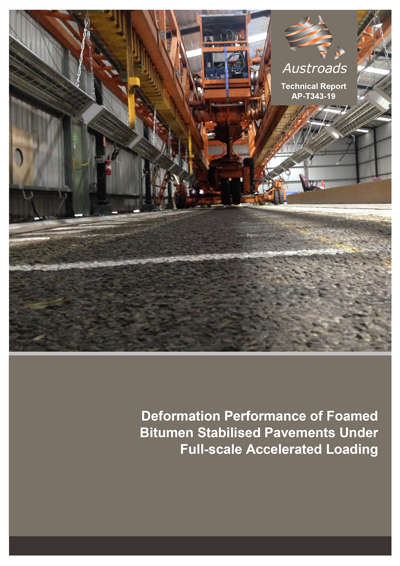Pavement

- Publication no: AP-T343-19
- ISBN: 978-1-925671-97-1
- Published: 5 March 2019
- PDF (free) Download
This report details the first phase of Austroads project TT2046 Improving the Cost Effectiveness of Foamed Bitumen Stabilised Pavements which evaluated the deformation performance of foamed bitumen stabilised materials.
The project assessed a crushed rock and a 50% reclaimed asphalt pavement blend under accelerated loading using the ARRB accelerated loading facility. Early-life performance was investigated by trafficking two days after construction and sealing. The performance was also evaluated after at least three months of curing. The deformation characteristics were measured with the test pavement heated to around 40 ⁰C at mid-depth to simulate warm weather conditions. The performance of the cured pavement was benchmarked by testing an asphalt test section of known field performance. For both conditions the accelerated loading facility was equipped with a dual‑wheel assembly loaded to 50 kN.
The main findings were:
- The test pavement showed limited pavement surface deformation and low deformation rates under accelerated loading for both the early-life and cured conditions.
- When tested at the same temperature, the 50% RAP did not impact significantly on the performance of the pavement.
- The foamed bitumen stabilised pavements performed well compared with the asphalt control.
The project concluded the overall good deformation performance of the foamed bitumen stabilised materials. Subsequent laboratory wheel‑tracking tests will be performed to confirm the finding at higher temperature.
- Summary
- 1. Introduction
- 1.1 Background
- 1.2 Overall Project Objectives and Scope
- 1.3 Scope of the Report
- 2. Material Selection
- 2.1 Host Materials Selection
- 2.1.1 Crushed Rock
- 2.1.2 Reclaimed Asphalt Pavement (RAP)
- 2.1.3 Properties of the Untreated Crushed Rock and 50% RAP Blend
- 2.2 Selection of Binder Contents of the FBS mixes
- 2.2.1 Pre-construction Modulus Testing
- 2.2.2 Post-construction Modulus Testing
- 2.3 Surfacing of the FBS Base
- 2.4 Asphalt Mix
- 2.1 Host Materials Selection
- 3. Construction Summary
- 3.1 Pavement Composition and Layout
- 3.1.1 Pavement Composition
- 3.1.2 The Accelerated Loading Facility (ALF) Site
- 3.1.3 Test Pavement Layout
- 3.2 Asphalt Pavement Construction
- 3.3 Construction of FBS Mixes
- 3.3.1 Pilot Lane Construction
- 3.3.2 Placement of Host Materials
- 3.3.3 Foamed Bitumen Stabilisation of Test Lanes
- 3.4 Sprayed Sealing
- 3.5 Pavement Construction Evaluation
- 3.5.1 Base Thicknesses
- 3.5.2 Construction Sample Testing
- 3.5.3 FBS Density and Bitumen Content
- 3.5.4 Asphalt Density
- 3.6 Pavement Curing
- 3.1 Pavement Composition and Layout
- 4. Full-scale Accelerated Loading
- 4.1 Introduction
- 4.2 Testing Conditions Overview
- 4.2.1 Applied Loading
- 4.2.2 Environmental Conditions
- 4.3 Pavement Deformation Performance Monitoring
- 5. Early-life Deformation Performance
- 5.1 Introduction
- 5.2 Deformation Results
- 5.3 Summary of the Early-life Behaviour
- 6. Cured FBS Deformation Performance
- 6.1 Introduction
- 6.2 Performance of the FBS 0% RAP Mix
- 6.3 Performance of FBS 50% RAP in Experiment 3701
- 6.3.1 Details of Deformation Properties
- 6.3.2 Causes of the Differences Between the Right and Left Wheelpaths
- 6.3.3 Selected Performance Data
- 6.4 Performance of the 50% RAP Mix After Extended Curing
- 6.5 Summary of Findings
- 7. Comparison of FBS Mix Performance vs Asphalt
- 7.1 Introduction
- 7.2 Asphalt Deformation Results
- 7.3 Deformation of FBS Mixes Compared to Asphalt
- 8. Conclusions
- References
- Appendix A FBS Base Construction
- A.1 Crushed Rock Materials
- A.2 Test Pavement Construction Plant
- A.3 Pilot-lane Construction and Surfacing Trials
- A.3.1 Pre-construction Preparation for the Pilot-lane
- A.3.2 Lime Spread Rate Assessment and Stabiliser Warm-up
- A.3.3 Pilot-lane Stabilisation
- A.3.4 Surfacing Trials on the Pilot-lane
- A.4 Density and Grading of the FBS 50% RAP
- A.5 100% Crushed Rock FBS (FBS 100/0)
- Appendix B Asphalt Base Construction
- B.1 Size 20 mm Type SI Asphalt Material
- B.2 Field Sample Testing
- Appendix C Subbase Construction
- C.1 General
- C.2 Subbase Level Assessment
- C.3 Subbase Density Assessment
- C.4 Subbase FWD Assessment
- Appendix D Level and Thickness Data
- Appendix E Heating and Temperature Monitoring
- E.1 Pavement Heating Set-up
- E.2 Temperature Profile Analysis
- Appendix F Pavement Surface Deformation Data
- F.1 Surface Profilometry Deformation Data
- F.2 Profilometry Data Tables
- F.3 Comparison of the Deformation in the Two Wheelpaths
- F.4 Detailed Deformation Data Charts
- F.4.1 General
- F.4.2 Early life – FBS 0%RAP – Experiment 3707
- F.4.3 Early life – FBS 50%RAP – Experiment 3700
- F.4.4 FBS 0%RAP – Experiment 3706 (T = 38.4 ⁰C)
- F.4.5 FBS 50%RAP – Experiment 3701 (T = 43.7 ⁰C)
- F.4.6 FBS 50%RAP – Experiment 3702 (T = 38.6 ⁰C)
- F.4.7 Asphalt – Experiment 3703 (T = 42 ⁰C)
- F.4.8 Asphalt – Experiment 3704 (T = 50 ⁰C)
- Appendix G Pavement Investigation of Experiment 3701
- G.1 Introduction
- G.2 Infrared Image Monitoring During Stabilisation
- G.2.1 Homogeneity of the Stabilisation
- G.2.2 FBS Mix with 50% RAP
- G.2.3 FBS Mix with 0% RAP Experiment 3706
- Appendix H Post-trafficking Testing
- H.1 FBS with 50% RAP
- H.2 FBS with 0% RAP
